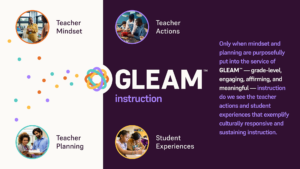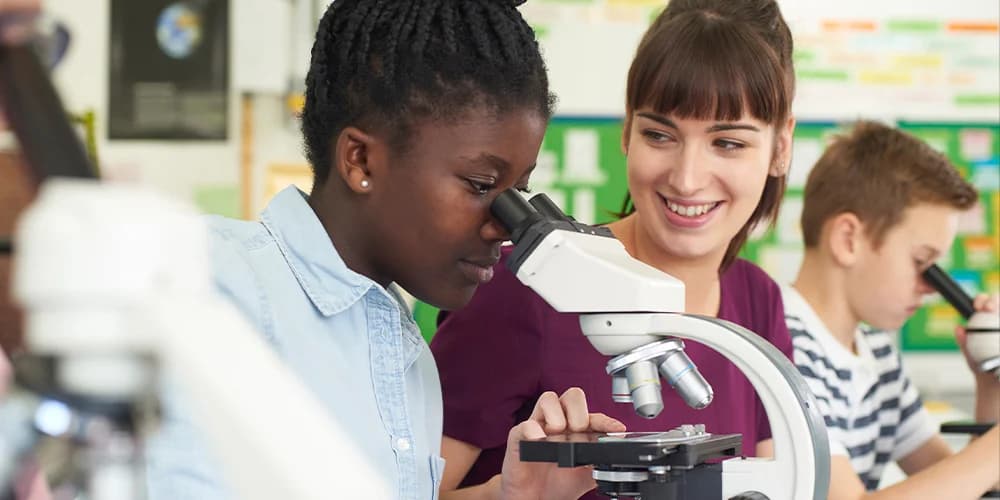We’ve shared ideas about what GLEAM can look like in our practices inside and outside the classroom, focusing on mathematics and English Language Arts (ELA) instruction. But what about science?

The work we do at UnboundEd is fundamentally grounded in what we’ve come to lovingly call GLEAM: instruction that is grade-level, engaging, affirming, and meaningful. As we have written about before, GLEAM isn’t a recipe or rubric; it encompasses mindsets, planning practices, teacher actions, and student experiences that have the power to disrupt inequities and cause conditions for our most marginalized students to thrive. Let’s take a closer look at what might characterize science that exemplifies GLEAM instruction!
Seeing Young Scientists
Let’s revisit a few components of our GLEAM mindsets and planning practices, such as these, where educators:
- View their role as preparing students for life rather than exclusively for achieving tasks, grade-levels, or standards.
- Know both grade-level academic standards and their students’ cultures.
- Believe that grade-level expectations can be met through relevant content and multiple ways of demonstrating knowledge.
- Adapt rigorous lessons from an aligned curriculum based on students’ background knowledge and cultures.
Fundamentally, science educators working to provide GLEAM instruction look at their students and see young scientists. They don’t see young people who are deficient, lack training, discipline, or experience; they see young people who are already actively examining and analyzing the physical world around them and are ready to work collaboratively to discover even more science. Science educators working towards GLEAM instruction take on the perspective and responsibility that their work goes beyond achievement on classroom tests and activities; they are developing young scientists to play active, investigative roles in their communities and workplaces.
Science educators espousing GLEAM instruction know that success means more than a student being able to memorize and recite Newton’s laws. Instead, they ask whether or not their students have the tools to understand and explain the world around them. GLEAM science educators emphasize the Science and Engineering Practices named in the Next Generation Science Standards (NGSS). With each lesson, they consider the ways they can set the conditions for their students to ask questions, define problems, construct explanations, and design solutions.
Concretely, GLEAM-minded science educators consider questions like these as they plan and reflect:
- What are my students curious about in the world around them? How can these curiosities relate to learning science at this grade level?
- How are my students already conducting investigations? How are they already constructing and communicating arguments? How can I build from their current strengths to expand their scientific knowledge and skills?
- What is the science my students have already figured out? What have they discovered about the world, and how can I use those discoveries to affirm my students’ identities as scientists in the making?
- What scientific histories and legacies are associated with the cultures represented in my classroom? How can these histories and legacies relate to science learning at this grade level?
Questions like these can help to serve as a springboard for educators to plan for GLEAM science instruction. They emphasize that GLEAM instruction is not about following a predetermined path. Rather, it begins with students: considering how their prior experiences making sense of the world can be welcomed and built upon in your classroom.
Young Scientists at Work
But what does this kind of science instruction look like in a classroom? How do the mindsets and planning practices of GLEAM science come to life in terms of teacher actions and student experiences?
We see students doing grade-level science. In a GLEAM science classroom, we see students developing questions, designing and performing investigations, and analyzing data in ways that echo the work of professional scientists. Rather than a focus on regurgitating information from the teacher or a textbook, students use science and engineering practices and crosscutting concepts to make sense of phenomena or design solutions for problems.
We see students invited to bring their whole selves to the science classroom. Teachers launch lessons using phenomena tied to the student experience. Having done the work of getting to know their students and their home lives, GLEAM-centered science educators invite students to share their experiences with phenomena, along with the tools and reasoning they have used to understand and explain science at home or in their neighborhood. Science teachers embody GLEAM instruction when they welcome students’ linguistic and cultural identities into the science work while at the same time ensuring they are also engaging with the vocabulary and methods described by the standards.
We see students doing science that is meaningful. Rather than building an understanding of phenomena in a vacuum, students learn science in ways that tie into sociopolitical contexts. How does climate change disproportionately impact communities of color? How can we ensure science is practiced equitably? How can science help us to advocate for our communities and address local and global challenges? These are just some of the questions young scientists might address in the course of GLEAM science instruction.
When we view students as already steeped in curiosity and their investigative methods, we can set the conditions for them to learn science every day in our classrooms. We can offer opportunities for them to learn science that does not require them to choose between their cultural identity and learning science, and that allows them to see science as a meaningful subject with community-based and global implications.
Ready to bring GLEAM™ science instruction to life in your classroom?
Are you a science educator or school leader looking to build increased student engagement and success with science in your classroom or at your school? Check out our new science pathway at our Standards Institute™, and please share this blog and let us know how this work is showing up in your schools and classroom; what are some other ways GLEAM instruction can manifest in science classrooms?
